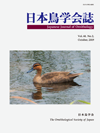Volume 68, Issue 2
Displaying 1-23 of 23 articles from this issue
- |<
- <
- 1
- >
- >|
SPECIAL ISSUE: Reintroduction of the Oriental White Stork in Japan
PREFACE
-
Article type: PREFACE
2019 Volume 68 Issue 2 Pages 181
Published: October 25, 2019
Released on J-STAGE: November 13, 2019
Download PDF (265K)
ARTICLES
-
Article type: ARTICLE
2019 Volume 68 Issue 2 Pages 183-192
Published: October 25, 2019
Released on J-STAGE: November 13, 2019
Download PDF (807K) -
Article type: ARTICLE
2019 Volume 68 Issue 2 Pages 193-208
Published: October 25, 2019
Released on J-STAGE: November 13, 2019
Download PDF (1226K)
SHORT NOTE
-
Article type: SHORT NOTE
2019 Volume 68 Issue 2 Pages 209-215
Published: October 25, 2019
Released on J-STAGE: November 13, 2019
Download PDF (876K)
REVIEW
-
Article type: REVIEW
2019 Volume 68 Issue 2 Pages 217-231
Published: October 25, 2019
Released on J-STAGE: November 13, 2019
Download PDF (1072K)
SPECIAL ISSUE: Island ecosystems and alien invasive mammals
PREFACE
-
Article type: PREFACE
2019 Volume 68 Issue 2 Pages 233-235
Published: October 25, 2019
Released on J-STAGE: November 13, 2019
Download PDF (405K)
REVIEWS
-
Article type: REVIEW
2019 Volume 68 Issue 2 Pages 237-262
Published: October 25, 2019
Released on J-STAGE: November 13, 2019
Download PDF (1795K) -
Article type: REVIEW
2019 Volume 68 Issue 2 Pages 263-272
Published: October 25, 2019
Released on J-STAGE: November 13, 2019
Download PDF (1053K)
ARTICLES
-
Article type: ARTICLE
2019 Volume 68 Issue 2 Pages 273-287
Published: October 25, 2019
Released on J-STAGE: November 13, 2019
Download PDF (1604K)
REVIEW
-
Article type: REVIEW
2019 Volume 68 Issue 2 Pages 289-306
Published: October 25, 2019
Released on J-STAGE: November 13, 2019
Download PDF (733K)
ARTICLES
-
Article type: ARTICLE
2019 Volume 68 Issue 2 Pages 307-315
Published: October 25, 2019
Released on J-STAGE: November 13, 2019
Download PDF (774K) -
Article type: ARTICLE
2019 Volume 68 Issue 2 Pages 317-325
Published: October 25, 2019
Released on J-STAGE: November 13, 2019
Download PDF (857K) -
Article type: ARTICLE
2019 Volume 68 Issue 2 Pages 327-333
Published: October 25, 2019
Released on J-STAGE: November 13, 2019
Download PDF (522K)
SHORT NOTES
-
2019 Volume 68 Issue 2 Pages 335-341
Published: October 25, 2019
Released on J-STAGE: November 13, 2019
Download PDF (493K) -
Article type: SHORT NOTE
2019 Volume 68 Issue 2 Pages 343-347
Published: October 25, 2019
Released on J-STAGE: November 13, 2019
Download PDF (457K) -
2019 Volume 68 Issue 2 Pages 349-355
Published: October 25, 2019
Released on J-STAGE: November 13, 2019
Download PDF (960K) -
Article type: SHORT NOTE
2019 Volume 68 Issue 2 Pages 357-365
Published: October 25, 2019
Released on J-STAGE: November 13, 2019
Download PDF (1526K) -
Article type: SHORT NOTE
2019 Volume 68 Issue 2 Pages 367-373
Published: October 25, 2019
Released on J-STAGE: November 13, 2019
Download PDF (953K)
OBSERVATIONAL DATA
-
Article type: OBSERVATIONAL DATA
2019 Volume 68 Issue 2 Pages 375-378
Published: October 25, 2019
Released on J-STAGE: November 13, 2019
Download PDF (851K) -
Article type: OBSERVATIONAL DATA
2019 Volume 68 Issue 2 Pages 379-381
Published: October 25, 2019
Released on J-STAGE: November 13, 2019
Download PDF (614K) -
Article type: OBSERVATIONAL DATA
2019 Volume 68 Issue 2 Pages 383-387
Published: October 25, 2019
Released on J-STAGE: November 13, 2019
Download PDF (652K)
OTHER ARTICLES
-
Article type: OTHER ARTICLE
2019 Volume 68 Issue 2 Pages 388-390
Published: October 25, 2019
Released on J-STAGE: November 13, 2019
Download PDF (370K) -
Article type: OTHER ARTICLE
2019 Volume 68 Issue 2 Pages 391-392
Published: October 25, 2019
Released on J-STAGE: November 13, 2019
Download PDF (309K)
- |<
- <
- 1
- >
- >|
